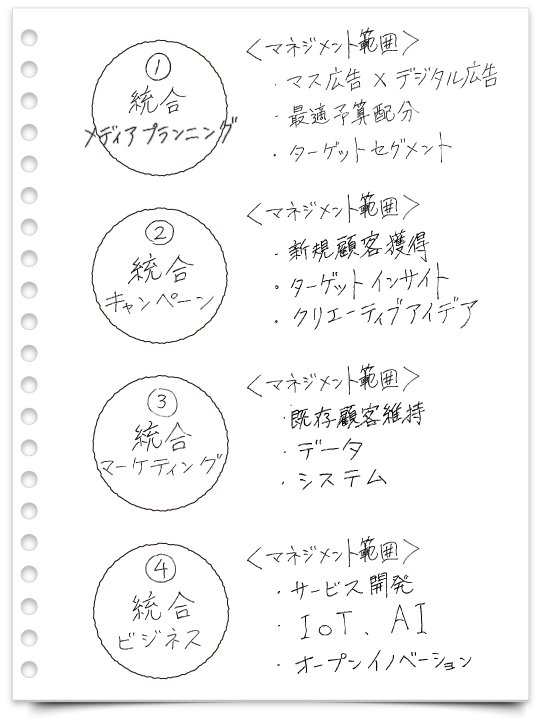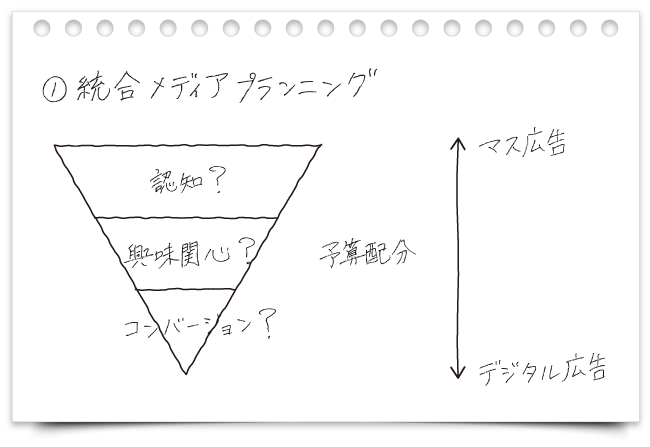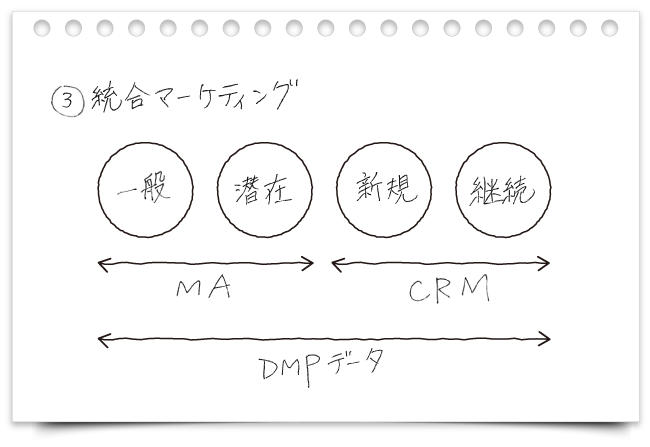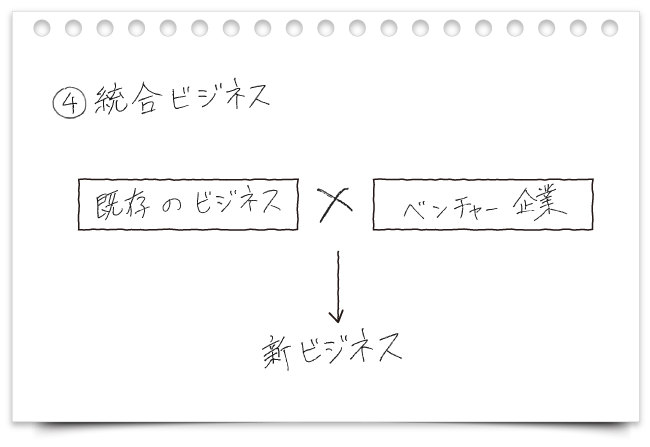Ⅰ What to Integrate? The Four Areas Managed by the CMO
In Part 1, we introduced that the roles of the CMO (Chief Marketing Officer), Marketing Director, and Brand Manager (hereafter referred to as "CMO, etc.") in digital marketing are "overall optimization" and "creating an environment for innovation." We also outlined the four key perspectives to consider when driving this forward:
・People…General consumers, customers, brand fans, etc., whose understanding deepens with richer data
・Brand … Products/services that continuously improve in quality through digital adoption
・Integration…Seamless customer touchpoints and experiences that blend digital and physical
・KPI…Key performance indicators that have become increasingly measurable through digitalization
CMOs and similar roles must holistically manage marketing-related departments to advance "overall optimization" and "creating an environment for innovation" through these four perspectives.
While the scope currently managed by CMOs and others is extensive, it can be categorized into four areas: ① Integrated Media Planning, ② Integrated Campaigns, ③ Integrated Marketing, and ④ Integrated Business.

[Four Areas of Integrated Management] CMOs and similar roles implement integrated management across these four areas to achieve overall optimization and drive innovation.
① Integrated Media Planning
The first is "Integrated Media Planning," which optimizes the media mix of mass advertising and digital advertising. With digital advertising playing an increasingly significant role, the challenge lies in coordinating and optimizing mass and digital advertising.
Here, the overall media budget is allocated from a holistic optimization perspective. The budget allocation ratio between mass media and digital advertising varies depending on the priority objective: whether it's "expanding brand awareness," short-term "sales acquisition," or an intermediate goal like "increasing interest in the product/service."
If brand awareness expansion is the priority, TV commercials remain highly efficient. If short-term conversion acquisition is emphasized, digital advertising proves more effective.
The priority between mass advertising and digital advertising also changes based on the status of marketing STP (Segmentation, Targeting, Positioning). Factors include the awareness level (S) of the target segment, the current state of the product/service and brand strength (P), and the competitive environment with rivals. Therefore, determining what to prioritize and setting the purpose and goals for media utilization is the responsibility of the CMO and others.
② Integrated Campaigns
The second is the "Integrated Campaign," which involves planning and executing campaigns holistically over a set period. This includes developing the content for media placement, such as branding and creative elements, and implementing it.
This involves examining the appeal of TV commercials for the master target audience and then determining how to approach and what to communicate to each segmented target audience through digital initiatives after TV commercial awareness. The goal is to achieve campaign success by leveraging both mass advertising and digital advertising from an overall optimization perspective.
In this integrated campaign, key elements include designing the content for media like TV commercials and digital ads. This involves new customer acquisition, target insights, brand differentiation from competitors, and developing messages for products/services and the brand itself.
③ Integrated Marketing (Always On)
The third is "Integrated Marketing." Unlike campaigns, this refers to the integration of the entire marketing domain, encompassing everything from new customer acquisition to CRM, targeting general consumers, potential customers, existing customers, and repeat customers. This area also involves investments in marketing systems, such as implementing MA (Marketing Automation) tools and DMP (Data Management Platforms).
Integrated Marketing is termed "Always On" because it emphasizes maintaining continuous, ongoing relationships with customers, not just temporary engagement during campaigns. Key elements include retaining existing customers, utilizing customer data, building systems, and developing ongoing content for company websites, SNS, and other platforms.
④ Integrated Business
The fourth area is "Integrated Business." This encompasses developing new marketing services, exploring digital overlay (fundamentally transforming existing service experiences through digital means), and new business development. Examples include developing new services utilizing AI. Recently, even large corporations are collaborating with startups, exploring business development leveraging digital through open innovation.
In terms of the two roles of the CMO—“Overall Optimization” and “Creating an Innovation Environment”—the “Integrated Media Planning,” “Integrated Campaign,” and “Integrated Marketing” domains focus on maximizing effectiveness and efficiency from an overall optimization perspective. Meanwhile, the “ ,” “Integrated Marketing,” and “Integrated Business” domains explore innovation investments, such as introducing digital systems.
Ⅱ Enhancing Appeal Through Synergy Between Campaigns and Always-On
Solving challenges through integrated management involves a process of clarifying the priority of individual issues and resolving them as they arise, rather than simply consolidating the entire scope, due to the broad nature of the management domain.
CMOs and others must now focus particularly on unlocking synergies between "Integrated Campaigns" (Campaign) and "Integrated Marketing" (Always On) to optimize marketing.
In "Integrated Marketing," various marketing systems like MA, CRM, and DMP are implemented to achieve ONE to ONE marketing. Consequently, the dilemma of individual optimization may arise: over-segmenting targets and messages risks failing to communicate the unique differentiation points of the brand's specific products/services.
While individual optimization can increase success rates, enabling "marketing that avoids major failures," it conversely makes achieving "highly successful marketing" difficult.
It is also crucial to avoid approaches that lack consideration for the customer's perspective, such as retargeting that repeatedly shows the same digital ad to visitors of the company's website or emails sent via MA.
For example, digital ads targeting people searching for high-spec DSLR cameras should not merely repeatedly emphasize those specs. Instead, they should be designed as part of an integrated campaign that stimulates the target audience's insights.
While the stated purpose is "capturing beautiful memories at my child's sports day," the purchasing father has hidden insights. For instance, might it be the desire to show others "how he's the one using a premium DSLR camera, outshining other dads"?
Assuming this, it's effective to implement self-projection appeals through digital retargeting ads or MA emails. This could include messages like "Thanks, Dad, for taking such great pictures!" from the child perspective, or featuring celebrity dads who look cool using that DSLR.

Even when utilizing marketing systems or digital advertising, it's essential to first consider the brand's raison d'être – its "Why." Beyond profiling each target segment, it's crucial to uncover hidden feelings that data alone can never reveal and stimulate those insights. Awakening interest and curiosity in the brand, product, or service, and fostering affection for it, is paramount.
On the other hand, "integrated campaigns" also present challenges. While campaigns centered around TV commercials, executed with substantial budgets, can efficiently expand brand and product/service awareness, they differ from digital advertising in that adjustments during the campaign period are difficult. This significantly increases the risk of failure. They must be implemented only after meticulous strategy and thorough consideration of ideas.
The role of the CMO and others is to organically leverage both "integrated marketing," which tends to be Always On-oriented and system-dependent, and "integrated campaigns," which tend to be campaign-oriented and rely heavily on insights and creativity.
Consider incorporating the insight-driven approach of "integrated campaigns," which move people emotionally, into "integrated marketing." Alternatively, explore using the systems of "integrated marketing," capable of precisely targeting diverse audiences, within TV commercial-centric "integrated campaigns." The fusion of "system approaches × insight approaches" will increasingly determine the competitive advantage of brands and products/services.
Expectations are now high for CMOs and others to realize sessions bridging Campaign and Always On.









